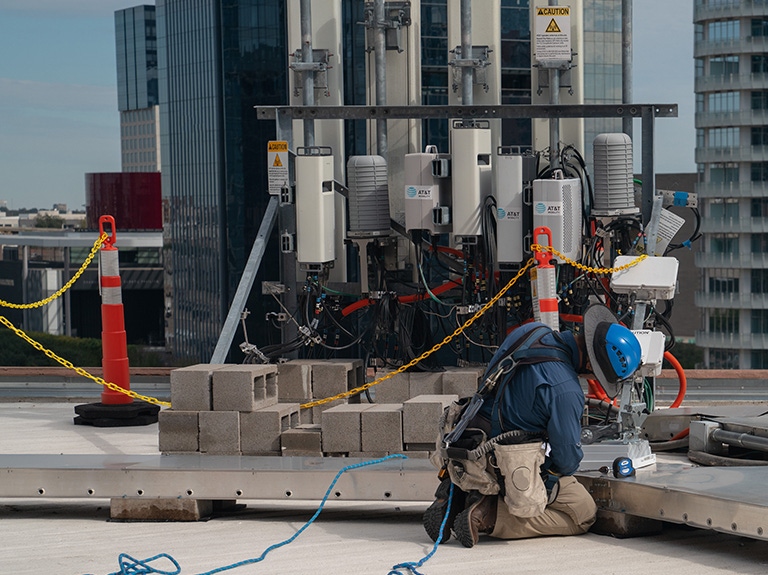
AT&T blamed its lower-than-expected 2024 profit forecast in part on its plan to tear out Nokia's equipment from its network and replace it with 5G equipment from Nokia rival Ericsson.
Specifically, AT&T said its write-down of Nokia equipment will reduce its annual earnings per share (EPS) by 17 cents. Overall, AT&T said it expects its adjusted EPS to be between $2.15 and $2.25 per share in 2024, a forecast that Reuters noted is below analyst estimates of $2.46.
"Our full-year guidance reflects a non-cash headwind," explained AT&T CFO Pascal Desroches Wednesday during AT&T's quarterly conference call. He said a portion of that headwind will come from "accelerated depreciation on Nokia assets impacted by our open RAN transformation, and we expect this impact to continue from 2026."
That's not a surprise. "We're going to shorten the lives of our Nokia equipment as we replace it with Ericsson," Desroches said in December. "So that's going to result in some incremental depreciation for next year, non-cash depreciation." But at that time he did not specify the scale of the depreciation.
In its fourth quarter earnings announcement Wednesday, AT&T disclosed the other factors that will affect its 2024 profitability forecast. Those factors include pension and post-retirement benefits costs, lower capitalized interest, and lower adjusted equity income from AT&T's DirecTV investment. But all those other factors together add up to just 15 cents per share – less than the 17 cents per share AT&T is taking on Nokia's equipment.
According to AT&T CEO John Stankey, there's a reason the operator shifted from Nokia to Ericsson via the five-year, $14 billion deal AT&T inked with Ericsson late last year. Without naming Ericsson specifically, he said AT&T enjoyed a "vendor circumstance like we've seen in wireless where somebody comes in and changes pricing and we get more efficiencies out of something."
Long-term savings
Stankey also said AT&T's shift to open RAN (O-RAN), via its deal with Ericsson, will help the operator reduce expenses over the long term.
"The fact that we're moving to O-RAN will give us another way to manage some of our capital intensity moving forward," he explained on AT&T's earnings call. "It's not going to get us to different levels of historic investment, but it will be one of the tools that we do to manage our portfolio of capital investment between fixed and mobile services to drive the kind of returns we need to drive. We're going to get more tools out of our O-RAN investment and still meet the needs of our capacity growth in a more efficient fashion in our wireless network moving forward."
And what of the economics for Ericsson? "This is the biggest contract in Ericsson's history," said Fredrik Jejdling, the head of Ericsson networks. But it won't provide any "meaningful" uplift to Ericsson's revenues until the second half of this year, according to the company's latest financial update.
AT&T's deal with Ericsson also positions Japan's Fujitsu to join Ericsson in supplying radios for AT&T's 5G network. But the scale of Fujitsu's role remains unclear. "That depends on what type of equipment AT&T would ultimately buy into an open RAN network," explained Ericsson's Jejdling.
Another quarter of growth
In its fourth quarter earnings report, AT&T said it added a total of 526,000 net postpaid phone customers, widely considered the most valuable type of wireless customer. That figure is noteworthy considering Verizon a day earlier reported net additions of 318,000 postpaid phone customers. The figures are generally higher than what most analysts had expected.
"After Verizon's big beat yesterday, investors have been asking who will miss," wrote the financial analysts at New Street Research in a note to investors Wednesday following the release of AT&T's earnings results. "We were pretty sure it wasn't AT&T. ... We are pretty sure it isn't T-Mobile either. We are pretty sure it isn't Comcast, given how they leaned into the product towards the end of the year. Our base case is that the postpaid segment grew faster than expected."
T-Mobile and Comcast have yet to report their fourth quarter results.
AT&T's Stankey suggested that ongoing growth in the US wireless postpaid industry would continue into 2025. Specifically, he said "we're at a more normalized level" of industry growth. Meaning, the US wireless industry collectively will continue to grow at a faster clip than it did previously, and will not dramatically slow as many analysts had expected.
Finally, AT&T's CEO also suggested that the operator will pursue pricing increases in the same way Verizon and others are doing.
"That value [AT&T is providing to its customers] is allowing us to go in ... and certainly drive some remuneration to the level of investments we're putting in," Stankey said in response to a question about possible price increases. "I expect we'll have to do that in 2024."
About the Author(s)
You May Also Like




_International_Software_Products.jpeg?width=300&auto=webp&quality=80&disable=upscale)







